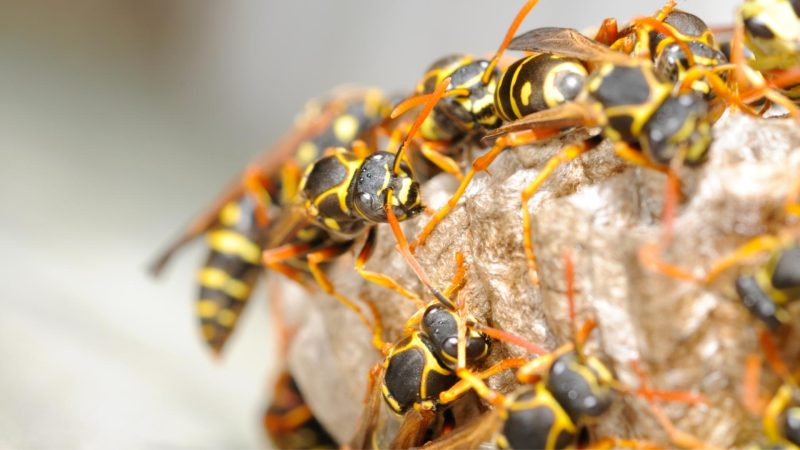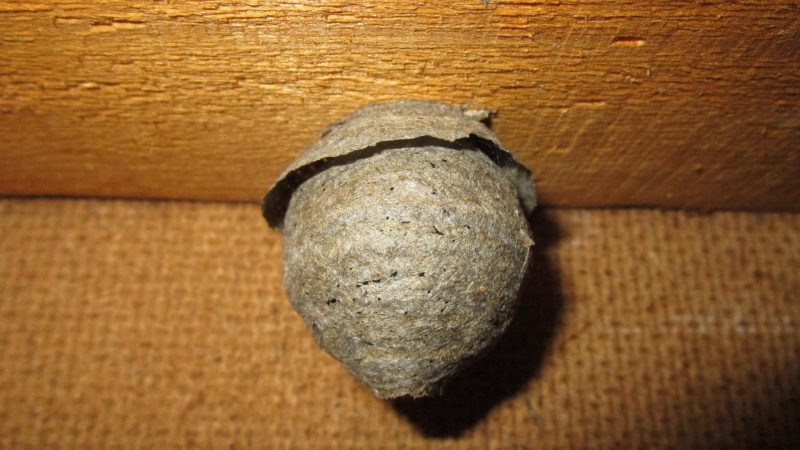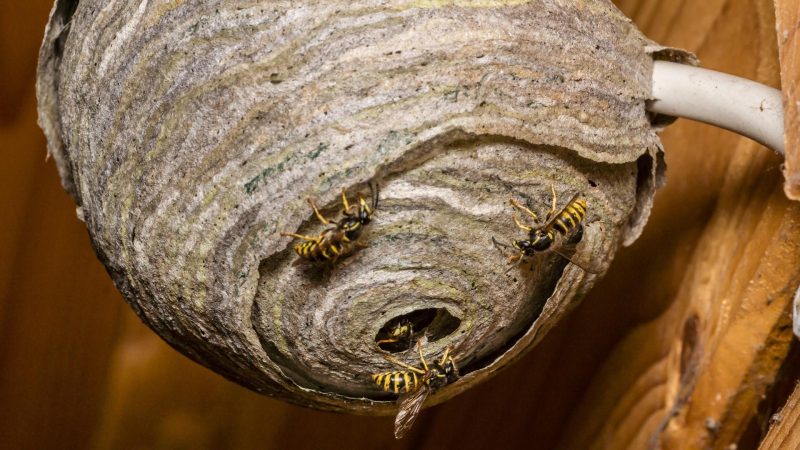Wasp nests come in different sizes and are potentially dangerous if they are nearby. This is because wasps are generally protective of their nests and their stings are quite painful.
Although most wasps build nests in hidden and sheltered areas and away from human activity, you should still be aware of your safety.
How long does a wasp nest last? Most wasp nests last for one year only. The queen usually leaves in the winter to rest, but her workers will remain. These workers will eventually die due to cold weather or starvation. The following spring, the queen will come out and will build a new nest instead of using the old one.
To start with, there are two kinds of wasps – social and solitary. Among the social wasps are yellowjackets, hornets, and paper wasps, while solitary wasps include spider wasps and cuckoo wasps. In this article, you will learn everything about social wasp nests and how to deal with them safely and correctly.
Table of Contents
What Does a Wasp Nest Look Like?

Generally speaking, wasp nests are nests with a small opening where wasps can enter and exit from. A hanging wasp nest looks like a hardened blob or a ball with an uneven shape and a papery appearance.
Paper wasp nests resemble an open umbrella, while hornet nests are pear-shaped and have a hardshell cover.
A paper nest is more slender and longer than a yellowjacket nest and is smaller than hornet nests. Most wasp nests are light brown, while some are gray.
The size of a wasp nest depends on the number of cells inside. According to Guinness World Records, the world’s largest wasp nest is 12 ft. 2 inches (3.7 m.) long.
How to Find a Wasp Nest?
Wasp nests can either be exposed or hidden. If they are exposed, you can find them hanging from horizontal surfaces such as a tree branch, overhangs, porch ceilings, and eaves of a house or building, which are the most common. For hidden nests, you may find them in attics, wall voids, spaces under stairs, etc.
For yellowjacket nests, you can find them on the ground, especially in old rodent burrows. However, you may not be able to see the actual nests since they are also hidden. To make sure if there is a nest in a hidden area, check if wasps are flying back and forth to that area and look for the nest opening.
How Many Wasps Are in a Nest?

The number of wasps inside a nest depends on how many there are in a colony. On average, a paper wasp nest has about 20-30 adults but may reach 100.
Meanwhile, a mature colony of hornets consists of 200 to 400 adults. Amazingly, a yellowjacket nest can have 45 cells, and may contain up to 20,000 workers!
What Are Wasp Nests Made Of?

Wasp nests are generally made of paper pulp, which is a mixture of chewed wood fibers and wasp saliva. Wood fiber can be from houses, fences, trees, logs, or cardboards.
Ground nests of yellowjackets are also made from paper-like materials, while nests of solitary wasps are usually made of paper pulp and mud.
How Do Wasps Make Nests?
Social wasps have a fertilized queen, which chooses the right place to build a nest. She will then start collecting wood fibers and construct the nest, along with hexagon-shaped paper cells.
These cells are attached side by side. Once the workers are old enough, they will continue building the nest.
Despite being compact, each cell is big enough for the queen to lay a single egg. The queen leaves food so that once the eggs hatch, the larvae can already eat.
These cells also serve as cribs for the pupae until they become adults. Hornets cover their nests with an envelope of paper pulp, while paper wasps don’t.
What Time Do Wasps Go to Their Nest?

Wasps go to their nest at dusk and will remain there the whole night until early morning. Once there is already a new queen, she will abandon the nest to start a new colony somewhere else but sometimes near their original nest. Wasps usually use their nests only for a year and will not use the same nest again.
How Do Fake Wasp Nests Work?
Some people hang some fake wasp nests, hoping that wasps will not create a nest beside them. Wasps are known to be territorial and may not build a nest near another nest.
Artificial wasp nests are usually made of paper and wire and look like a real wasp nest. But to work effectively, you may need lots of them.
How to Safely Remove a Wasp Nest?
Removing a wasp nest is not always as easy as you think. Social wasps can be aggressive and will sting painfully once you try to destroy their nest.
Aside from that, wasps can sting multiple times since they don’t leave their stingers on the skin. To be safe, here are some do’s and don’ts when removing a wasp nest:
- For ground nests, you can easily destroy them by applying insecticidal dust such as Garden Tech Sevin 5-Percent Dust Bug Killer on the nest opening. Don’t cover the nest so that wasps can leave peacefully. Dust insecticides perform better than in liquid form.
- For an exposed hanging nest, use aerosol spray designed specifically for wasps, hornets, yellow jackets. EcoSMART Organic Wasp and Hornet Killer is one of the most trusted ones.
- For hidden wasp nests, don’t spray the opening because wasps can still escape. Apply dust insecticides instead.
- When using a spray, stand at about 20 feet away from the nest. Read the label carefully and follow the instructions religiously.
- For any kind of action, always wear safety glasses, gloves, and clothing.
- Don’t treat a wasp nest if you are allergic to wasp stings or you have a heart condition. Instead, ask for help from a licensed pest control professional.
- If wasp nests are far from you and are not a threat, wait until fall when all the wasps leave the nest or die naturally. Then, gently cover the nest with a plastic bag and remove it carefully. To make sure all the wasps inside are dead, place the plastic bag inside the freezer overnight.
When to Spray a Wasp Nest?
If you will use a spray against a wasp nest, do it at night or early morning when wasps are inside their nest and are inactive. During this time, your chance of getting stung is also greatly reduced. However, wait for at least 24 hours before touching or removing the nest and make sure there is no more wasp activity.
How to Get Rid of a Wasp Nest Naturally?
Some insecticides contain harsh ingredients that can harm people and animals, especially indoors. So, if don’t want to use insecticides, here are some tips on how to get rid of a wasp nest naturally:
- Try spraying soapy water to the nest. To be more effective, add a few drops of essential oils, such as citronella, geranium, clove, sage, lavender, lemongrass, rosemary, and peppermint.
- If you are sure that you are dealing with a yellowjacket nest, install sticky traps near it. Traps such as RESCUE! Reusable Yellowjacket Trap has no chemicals and contains attractants that yellowjackets cannot resist.
- If you are not sure what type of wasp nest it is, better to use a wasp trap such as RESCUE! WHY Trap for Wasps, Hornets, & Yellowjackets.
- As mentioned earlier, you can also wait for fall, when wasps die naturally or leave the nest. If you are sure that the nest is already empty, remove it slowly.
How to Keep Wasps From Building Nests?
Wasps are stubborn creatures and will build nests anywhere they feel safe and comfortable. Although most wasps die in the winter and rarely reuse their nests, they can still be nuisances once their nests are near your house. With that, here are some useful tips on how to prevent wasps from building nests:
- Yellowjackets are scavengers, so always cover your trash cans properly. If you are feeding your pet cats or dogs outside, remove their bowls immediately after eating.
- Plant some trees that deter wasps. This includes citronella, clove, lavender, lemongrass, and peppermint.
- Hang fake wasp nests such as AIRCROW Wasp Out Fake Hornet’s Nest. Although some skeptics doubt their efficacy, many certified buyers said that they are effective.
Summary
No matter how big or small a wasp nest is, it cannot be considered dangerous if it is far away from your home. Remember, wasps only sting if they are disturbed or threatened. Although wasps are not as efficient pollinators as bees, they are also beneficial to plants. So, if they are not bothering you, don’t bother them, too.
List of Sources
Bee, Wasp or Hornet Nest: Which One Is It?